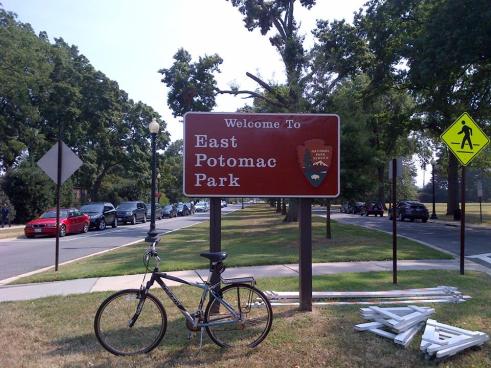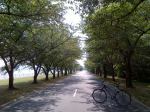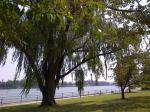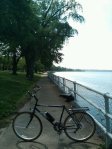For this lunchtime bike ride, I rode to D.C.’s Southwest neighborhood to go to the Southwest Duck Pond, also known more formally as Town Center West Park. Located at the corner of Sixth and I Streets (MAP) and just a couple short blocks from D.C.’s Southwest Waterfront, the park functions as a green counterpoint to its urban surroundings by filling up a square block with greenery and a pond meant to attract wildlife.
The park was originally designed by William Roberts of Wallace McHarg Roberts & Todd for the National Park Service as part of the early 1970’s urban renewal projects in the Southwest Washington Redevelopment Area. Completed in 1972, the park served as an urban retreat, providing a quiet spot among the city’s hustle and bustle for local residents, office workers, and students of an adjacent school for exceptional children, and was part of a larger effort to enhance and increase recreational space in the neighborhood.
For the next few decades the park was generally well-maintained by the National Park Service in conjunction with the National Mall and Potomac Park. Then, in 2007, after ownership and responsibility for the park was transferred to the D.C. Department of Parks and Recreation, the park began to fall into disrepair. Eventually, overgrown landscaping caused the grounds to appear unkept, the brick retaining walls showed significant deterioration, and even the water circulation pumps and the fountains in the pond stopped working. The park was in such bad shape that a case of West Nile Virus was thought to be caused by the stagnant water in the park, which because of the lack of circulation in the pond caused mosquitoes to breed in the area and spread disease.
After efforts by the city and private developers failed to result in improvement, some local residents formed an organization called Neighbors of Town Center West Park to care for the park and serve as an advocacy group. The group of volunteers began by picking up trash and doing other maintenance at the park. Over time, the group was designated by the local Advisory Neighborhood Commission as the official community representative for the park. With this designation, the group now participates in the city’s Park Partners program.
Today, the condition of the park stands in stark contrast to its recent history as it has been returned to it’s earlier days’ prominence. The pond’s water circulation and four fountains have been replaced. The pond’s naturalistic shoreline, broken by three promontories edged with river rocks, is surrounded with native riparian plants. The interior of the park is planted with large shade trees, and lined by repaired or replaced low brick retaining walls which give it a sense of enclosure. And a circulating walkway connects each of these areas. New park benches line the paths, along with new sidewalks, streetlights, and even some bike racks.
Additionally, the Neighbors of Town Center West Park group, which recently changed its name to Neighbors of Southwest Duck Pond, hosts activities in the park, including The Little Farm Stand farmers market, community open houses, ice cream socials, holiday parties, and neighborhood happy hours. The park is now more than a place just for nearby neighbors, it has become a destination location for everyone.












